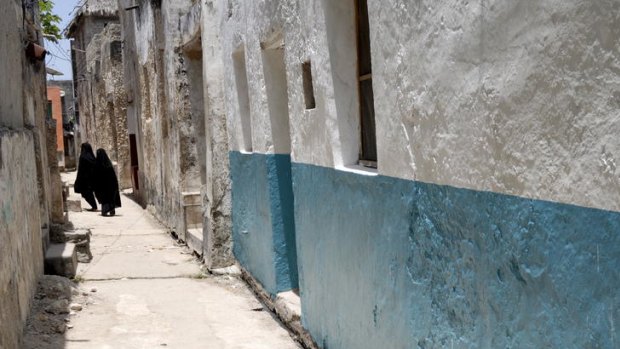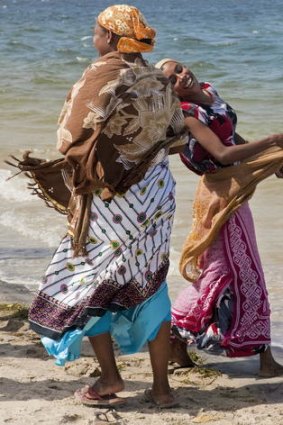
Fragile beauty ... the limestone streets of town.Credit: Getty Images
On the island of Lamu, Lance Richardson discovers the impact on a community when tragedy means the tourists stop coming.
IT IS Eid al-Adha, the annual Muslim holiday. I wake to the sound of gentle chants drifting across the water like rich incense.
I'm not sure what the voices mean, though later I will read that Eid al-Adha, the "festival of sacrifice", commemorates Abraham's obedience to God in giving up his son. To mark this holy occasion, people offer food to the poor and ask Allah for forgiveness.
As I pull back the mosquito net and climb out of bed, I wonder instead if they're asking for a respite from the heat, which gathers strength for a midday assault so powerful that people languish in a daily stupor.
Or maybe they're asking for something else. Like rain in the north of Kenya, visitors have stopped flowing to the island of Lamu. Once flooded with tourism shillings, the old limestone streets of the town are running dry.
On September 11, two British nationals were attacked by Somali-based militants just north of Lamu; one died and the other was kidnapped. Then, on October 1, a French woman was kidnapped from Manda Island just opposite Lamu.

Locals on the beach.Credit: Getty Images
Two cases like these are enough to stifle most major destinations, let alone one as fragile as a tiny Kenyan community all but reliant on its constant stream of visitors.
In response to the attacks, the Australian government has issued advice to avoid all travel to the Lamu Archipelago.
While an intrepid traveller, I harbour no romances of piracy on the high seas. Nevertheless, visiting Kenya and invited by its tourist board to inspect Lamu's safety, I decide to fly in for a night. All travel is calculated risk but security in the area is extremely high, with the Kenyan navy sharing waters with sea-patrol vessels and the police.
Major hotels have also hired their own security forces, tucked along the beach like well-armed hermit crabs. Having travelled extensively, I know how tragic events can decimate a community reliant on tourism. I also know this is a story that often goes untold, lost in the chaos of hysteria and cancelled bookings. Speaking of the kidnappings, one local tells me: "It was like a stone falling from the sky."
There are many things to do in Lamu but I come simply to visit the people, to see the ripple effects from this stone.
My hotel is The Majlis, once a family home and now a cluster of well-appointed villas on Manda Island. With the exception of a visitor recuperating from a Mount Kilimanjaro climb, The Majlis sits empty, its exquisite luxury untouched beneath the fierce sun.
There are more guests opposite the channel in the upmarket area of Shela on Lamu Island, where Brad Pitt and Angelina Jolie celebrated the new year.
This is the exception, though.
After breakfast I take a boat to Stone Town, the oldest part of Lamu and its cultural heart. I'm met by Abdillahi Ahmed Sultan, a commanding guide who calls himself Bob, although others call him "the mayor of Lamu" for his all-encompassing knowledge.
When asked how many people have been visiting lately, he holds up his hand and forms a perfect "0", shaking his head. "But they'll come back. Lamu is still paradise."
As he says this, a group of young girls push past in their Sunday best, trailed by men wearing fez and white cotton trousers. It is a town of bicycles on the beach, minarets, mangoes and henna.
There are thousands of donkeys, too, the only transport capable of navigating the narrow streets created by houses huddling and leaning across to join together in domestic bridges. Everywhere I look I am met with curious faces, voices wishing me a happy holiday or offering baskets, avocados and tasselled blankets called kikoy.
According to Sultan's estimation, about 70 per cent of the town's 15,000 residents rely on tourism. And even people not directly affected by the drop in visitor numbers have related trials to contend with: the Kenyan navy has restricted access to the Somali border, where many residents go to fish in the populated waters. Now cargo boats sit moored by the dock, listing on exposed mudflats.
If there is any question of local culpability, it is a question quickly dashed by logic. To be complicit in piracy in a place where the economy hinges on foreign money is to condemn your own town to death.
Sultan, fiercely proud of Lamu, says residents have taken up the example of security forces, quizzing strangers and reporting unusual activity to the authorities.
A stroll through the quiet shops, where vendors, noting my presence, lay out their wares with a sudden manic vigour, shows how desperately the people need things to return to normal here.
This month marks the Lamu Cultural Festival, when the main square in front of the apricot-coloured fort transforms into a stage for singing, dancing and celebration. For now it's full of people simply waiting. I follow Sultan into the square, then watch as he bends down to speak softly with an old woman. Something passes between their hands, reminding me that it is Eid al-Adha. The woman is poor and barely able to move with her brittle body. Is this Sultan's way of asking his God for forgiveness on the sacred holiday?
Visitors must forgive a place in their own time. All upsets need time to heal and the Australian government's warning remains in place. But New York bounced back after the attacks of September 11, 2001; Bali has once again become a popular destination in spite of its infamous bombing.
I am in Lamu, writing on the beach. Children play all around me. A donkey lays in the sand, working on a tan. A parrot screeches in its cage under an acacia tree. "Jambo!" it calls, greeting the world.
The writer travelled courtesy of the Kenya Tourist Board and Air Mauritius.
Trip notes
Getting there
Air Mauritius flies to Nairobi from Sydney, 1300 332 077, airmauritius.com. From Nairobi, several domestic carriers fly to Lamu daily, including SafariLink and Fly 540, Fly540.com.
Staying there
The Majlis is the best hotel. Rooms start at €400 ($535) a night for a single deluxe room, themajlisresorts.com.
More information
Sign up for the Traveller Deals newsletter
Get exclusive travel deals delivered straight to your inbox. Sign up now.